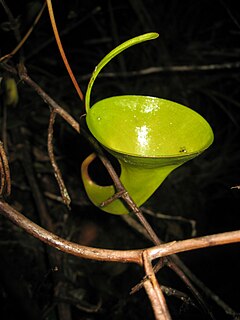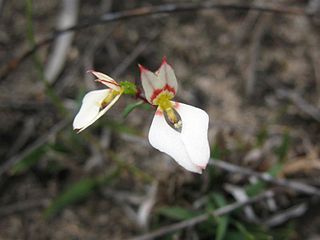
Phelsuma dubia, dull day gecko, olive day gecko, Zanzibar day gecko, or green day gecko is a diurnal species of gecko. It is about 15 centimetres (5.9 in) in length and lives on the western coast of Madagascar, in the Comoros, and the coast of East Africa. It typically inhabits trees and can also be found near human dwellings. The Dull day gecko feeds on insects and nectar.
In zoological nomenclature, a nomen dubium is a scientific name that is of unknown or doubtful application.

Nepenthes dubia is a tropical pitcher plant endemic to Sumatra, where it grows at an altitude of 1600–2700 m above sea level. The specific epithet dubia is the Latin word for "doubtful".

Nepenthes tenuis is a tropical pitcher plant endemic to Sumatra. The species was first collected in 1957, from a remote mountain in the western part of the island. It remained undescribed until 1994, and was only rediscovered in the wild in 2002. Prior to this, N. tenuis was known solely from a single photograph and dried herbarium specimen.

Nepenthes inermis is a tropical pitcher plant endemic to Sumatra. The specific epithet inermis is Latin for "unarmed" and refers to the upper pitchers of this species, which are unique in that they completely lack a peristome.

Nepenthes izumiae is a tropical pitcher plant endemic to Sumatra, where it grows in montane forest at 1700–1900 m above sea level. It appears to be most closely related to N. lingulata and N. singalana.

Nepenthes jamban is a tropical pitcher plant endemic to northern Sumatra. The specific epithet jamban is the Indonesian word for "toilet" and refers to the shape of the pitchers.

Nepenthes × pyriformis is a natural hybrid involving N. inermis and N. talangensis. It is known only from Mount Talang in Sumatra, to which N. talangensis is endemic. Nepenthes talangensis was only described as a distinct species in 1994. Prior to this it was placed within N. bongso and some of the older literature identifies this hybrid as N. bongso × N. inermis.

The Dryomyzidae are a small family of flies ranging from 4–18 mm long, with prominent bristles, and yellow to brown or rust-yellow coloring. The wings are very large. The subcosta is complete and well separated from vein 1. Larvae feed on decaying organic matter - carrion, dung, and fungi. The prelambrum protrudes from the oral cavity. Vibrissae are absent and the postvertical bristles are divergent.

Macropterygius is a genus of ichthyosaurs known from the Late Jurassic of England. Though many specimens have been referred to this genus from all over Europe, the type specimen of the only recognized species, M. trigonus, consists of just a single vertebra. Because this cannot be used to distinguish ichthyosaurs from one another, the genus and species are currently considered nomena dubia.

Grevillea speciosa, also known as red spider flower, is a shrub which is endemic to New South Wales in Australia.

Clausilia dubia is a species of small, very elongate, left-handed air-breathing land snail, a sinistral terrestrial pulmonate gastropod mollusk in the family Clausiliidae, the door snails, all of which have a clausilium.

Levenhookia, also known as the styleworts, is a genus of ten recognized species in the family Stylidiaceae and is endemic to Australia. The genus is restricted to Western Australia almost exclusively with a few exceptions: L. pusilla's range extends into South Australia, L. dubia's range extends through South Australia into Victoria and New South Wales, L. sonderi is native only to Victoria, and L. chippendalei is also found in the Northern Territory.

The white-faced darter or small whiteface is a dragonfly belonging to the genus Leucorrhinia in the family Libellulidae, characterised by red and black markings and a distinctive white patch on the head. It is found in wetlands and peat bogs from northern Europe eastwards to Siberia, and the adults are active from around April till September, which is known as the "flight period". It breeds in acidic bodies of water, laying its eggs in clumps of sphagnum moss that provide a safe habitat for larval development. The larvae are particularly vulnerable to predation by fish, and so are usually found in lakes where fish are not present. L. dubia is listed as a species of least concern (LC) by the IUCN Red List, however, it is potentially threatened by habitat destruction, pollution, and climate change.

Blaptica dubia, the Dubia roach, orange-spotted roach, Guyana spotted roach, or Argentinian wood roach, is a medium-sized species of cockroach which grows to around 40–45 mm (1.6–1.8 in).

Ventenata is a genus of plants in the grass family, native to Europe, North Africa, and central + southwest Asia. One species, Ventenata dubia, is considered an invasive weed in many places.

Calochlaena dubia, commonly known as soft bracken, false bracken, common ground fern or rainbow fern, is a small Australian fern in the treefern family Dicksoniaceae. It is very common within its range, and often seen growing under eucalyptus forest, often on the poorer quality soils. It is an easy plant to grow in the garden.
Isotealia is a genus of sea anemones in the family Actiniidae.
Isotealia antarctica, the salmon anemone, is a species of sea anemone in the family Actiniidae. It is found in the southern Atlantic and Pacific Oceans and the waters around Antarctica. It is a filter feeder and opportunistic predator.
Tritoniella is a genus of sea slugs, specifically dendronotid nudibranchs. It is a marine gastropod mollusc in the family Tritoniidae. A monotypic genus, the only species is Tritoniella belli. The genus and species were both described in 1907 by the British diplomat and malacologist Charles Eliot.















